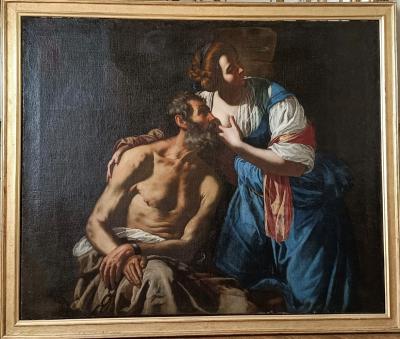Gentileschi painting recovered after illegal export thwarted

BARI- A 17th-century painting by Artemisia Gentileschi has been recovered after it was illegally exported from Italy in an attempt to market it abroad. The painting belongs to the legacy of Count Giangirolamo II Acquaviva, and was recovered and repatriated from Austria, and formerly kept at the Marchione Castle in Conversano (BA).
Two people investigated for fraud and illegal export of cultural goods.
Those currently under investigation, according to the indictment, had submitted the painting to the Export Office (of the Ministry of Culture) in Genoa in 2019 through a Tuscan intermediary agency. They had disguised the attribution to the Italian painter of the Caravaggio school Artemisia Gentileschi (1593 - 1653), declaring a decidedly underestimated economic value and concealing the historically documented link with listed architectural contexts (Conversano Castle and, later, Marchione Castle in Conversano, dating back to the 16th-17th century). They thus managed to obtain a certificate of free circulation vitiated by the erroneous representation and assessment of the facts underlying the decision of the Advisory Commission.
The private owners had removed the 17th century oil on canvas painting (cm. 121x147) of extraordinary historical-artistic value depicting Caritas romana (History of Cimone and Pero narrated by Valerius Maximus in Factorum et dictorum memorabilium libri IX) from Italian territory. It formerly belonged to the great art collection of Count Giangirolamo II Acquaviva of Aragon (1600 - 1665), who had commissioned it from the Roman painter around the middle of the 17th century, entrusting it to a prestigious Austrian auction house to maximise the economic revenue from the sale abroad of the work, which would have been definitively and irreparably removed from the national cultural heritage.
The investigation, started in early 2020, headed by the Carabinieri Department for the Protection of Cultural Heritage (TPC) in Bari, and directed by the Public Prosecutor's Office. The investigation has so far (without prejudice to any subsequent decision in the adversarial process of the parties) prevented the painting from suffering the same fate as another Artemisia Gentileschi painting from another collection that was auctioned at the same auction house for approximately 2 million euros. In fact, the offices of the Ministry of Culture were immediately alerted and, having administratively cancelled the authorisation issued on the basis of mendacious declarations concealing the certain attribution of the painting to the painter, they started the procedure that determined the cultural interest of the asset and the denial of its free circulation.
The non-observance of the order to repatriate the work, promptly ordered by the central bodies of the Ministry of Culture against the owners, generated an in-depth investigation by the Carabinieri TPC Unit of Bari, which requested the Judicial Authority to adopt measures aimed at preventing the dispersion, transfer, or sale of the asset, now destined to be sold at auction, thus removing it from the Italian cultural heritage.
After tracing the whereabouts of the painting to the auction house in Vienna, the military seized it in execution of a European Investigation Order (EIO) issued by the Public Prosecutor's Office of the Court of Bari, in execution of a freezing order provided for by European Regulation 1805/2018. A preventive seizure was also issued by the GIP of the Court of Bari in acceptance of the investigators' requests, making it possible - with the coordination of the European criminal judicial cooperation body Eurojust and the collaboration of the Austrian Police - to recover and repatriate the work. These actions saved it from the speculative mechanism implying the definitive removal of the asset from state control over cultural heritage, or its loss following its commercialisation abroad.
It is important to emphasise that the proceedings are at the preliminary investigation stage and that the defence of the suspects will follow, whose possible guilt, with respect to the alleged offences, will have to be ascertained at trial in the adversarial phase between the parties.
In the execution phase of the activities, the support of the Italian Embassy in Austria was crucial for the adoption of appropriate measures for the preservation of the work of art pending its repatriation to Italy.
The Superintendency of Archaeology, Fine Arts and Landscape for the metropolitan city of Bari will proceed with technical investigations on the canvas, together with the specialised ministerial institutes. An evidentiary accident has also been requested.
The value of the recovered work is no less than two million euros.
al
© COPYRIGHT ITALIAN INSIDER
UNAUTHORISED REPRODUCTION FORBIDDEN


